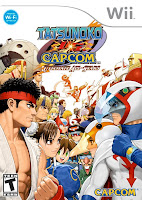
The last two years have seen an unexpected resurgence in 2d beat’ em ups, as well as various titles associated with the hardcore scene; Street Fighter, King Of Fighters and Bionic Commando all making their well deserved comebacks, with the mainstream stalwart NBA Jam recently added to the shortlist. So it comes as no surprise that another instalment of the popular Vs. series was on the cards and ready to cross-combo, super-cancel us into oblivion.
Tatsunoko Vs. Capcom has arrived!
Now nobody really expected this particular instalment to arrive on these shores, what with the many licensing issues plaguing the Tatsunoko brand over in Europe and the United States. In addition with what must have been some very obvious concerns as to whether it was worth the time and financial effort to do so, given the fact that the brand remains a virtual unknown around these shores.
However it seems that those problems have been taken care of, with the exception of Hakushon Daimao whose licensing in European left him shafted from the game. Other than that, everyone is correct and present, and making up for the delay Capcom have added in a few extra unlockable characters not found in the original Japanese version, and an online play option exclusive to us.
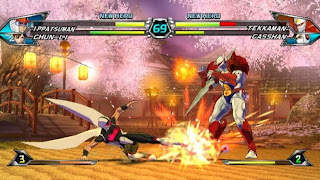
It’s a great thing; it really is, as TvC provides some of the most intensely enjoyable tag-team Vs. action since the original Marvel Vs. Capcom. Every aspect of Tatsunoko screams out personality on its sleeve, from the completely eccentric J-Pop infused theme song, to the bizarrely odd end credits sequence. You will find a mix of uniquely styled characters, impressive background set pieces, and some of the most balanced action the Vs. series has seen. And it’s all completely bonkers!
The basics are much the same as with previous games, albeit here they are slightly simplified. In Tatsunoko you only use three attack buttons, Light Medium and Heavy, with a fourth button dedicated to special attacks, like calling in your teammate for a few extra hits, or to simply tag them into action. Punches or kicks are dependent on which direction you push the d-pad or stick in combination with any of the three attack buttons. Sometimes the differences will be subtle, like going from a straight punch to a basic uppercut. Or if you happen to be jumping in for a basic combo run, a flying kick can change into a punch or throw, and then cancelled into a hyper using the P button followed by the correct motion.

This system at first feels a little random, however after a few play throughs you find that it has a huge level of depth. Just accurately thinking about which attack to use and in combination with what direction instinctively, is almost as deep in some circumstances as having the full six-button set-up. What’s more it allows a degree of simplicity allowing inexperienced players to effectively have a good button bash and feel like they are at least kinda playing the game properly. With the same token it allows anyone to step in and have fun, more so than with Street Fighter IV.
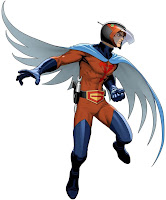
Then you have all the intricacies of the Assist Moves, Hypers, Team Hypers, and various other nuances, in which hardcore players like myself will no doubt spend many hours learning and exploiting in the heat of battle. In fact there’s so much to learn and master here, you could almost argue that it’s almost as complicated as SFVI. Just through the sheer amount of moves on offer and how they change with the different button presses and combo team-up scenarios.
Perhaps the most intriguing element of all this is, is how one special move can turn into three just by changing which button you use. The effect and outcome is completely different, allowing a great range of intros and juggles to be played even at the most basic level. You could even combine some of these with the basic L, M, and H in quick succession as a perfectly usable starter for some of the games more intricate combinations.
Of course this is using either the Arcade Stick or Classic Controllers. A much simpler Wii Remote, or Wii Remote + Nunchuck combination is also supported, which strips down the controls even further. Using this option there is only one button for regular attacks and one button for specials, with the moves you do depending on which direction the D-Pad or Analogue stick is pushed. However it’s not possible to pull of anything but simple combos along with some special moves and hypers.
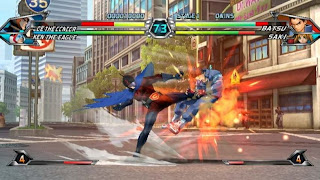
It’s lots of fun playing TvC, regardless of controller set-up, and the range of characters complement the move sets nicely. In fact anyone looking for various Ryu and Ken clone characters need not apply. Whilst the majority of moves are performed using the standard quarter-circle forward + attack technique, their styles can vary greatly. You won’t find twenty different versions of the same fireball or dragon punch here. In fact, the range on offer is something akin to an SNK fighting game, mixing many styles and personalities together.
In terms of modes, Tatsunoko Vs. Capcom simply features five; Arcade, Versus, Survival, Time Attack, Training, and Online. The Arcade Mode words as the game’s Story Mode, basically having you fight through a number of stages, coming up against a sub-boss around half way, and then squaring up against the obligatory final boss at the end. Versus, Training and Survival should all be is self-explanatory by now. And that just leaves Online.
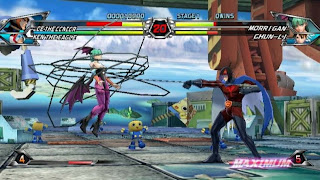
Online play in TvC works surprisingly well, with very little lag in matches both domestically and ones found half way across the world. It’s surprising good compared with the problems I’ve been having with lag in SFIV recently. Naturally, running only a 1 Meg (I’m being upgraded to 8 Meg as I write this apparently) connection means that I do frequently experience some small amount of lag in worldwide matches, though nothing game breaking. The largest problem is the barebones matchmaking system, and the hassle of having to enter those somewhat pointless friend codes. It is actually easier to set up a random match, in which the CPU automatically pairs you up with an opponent, and then select them as a friend when the match finishes rather than painstakingly add people manually.
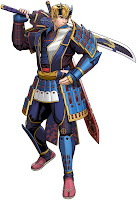
The only real issue is with regards to paired up matches. It’s completely automatic; to the point of where you literally cannot choose whom you fight against. This means you have no way of telling if the person you have been paired with has a good connection, though you can tell if they are of a similar skill level to you. A small icon lets you know what kind of player they are; defensive, offensive, combos-based etc. Plus looking at their Player Icon (like in SFIV) gives you a good idea; a higher end player is one most likely to have unlocked some of the really cool icons not available just by playing the single-player modes.
Unfortunately, whilst I was online I found there to be only a small community of players at any one time, and kept being pared up with the same three or four people constantly. I checked back a few hours later and things got much better, though bizarrely there were times in which I would go through a few different opponents, and then others where I was being pared with the same one a couple of times. This is perhaps the biggest problem with the auto matchmaking system; it can be really annoying to play against the same players over and over in such a short space of time.
So the single player modes work well enough, and the online is at least serviceable; well it’s outstanding in terms of performance, just poor in terms of matchmaking. However the game feels a little shallow with regards to the overall content available. It won’t take long to play through the game a few dozen times to unlock the extra characters and see all the endings, and then online with its limitations certainly won’t prove as addicting as SFIV service. But despite this TvC has so much going for it, and those issues niggling away at it are just that, little niggles which disappoint slightly but that don’t really damage the game.
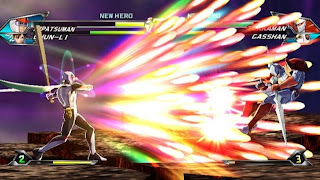
Graphically you’ll find that Tasunoko Vs. Capcom features some of the most exuberant and fantastical visuals on the Wii. The style presented here is in the same form as with Street Fighter IV; 2.5D polygonal models coated with rich hand painted textures, and some lovingly created frames of animation. Backgrounds are full of little details and moving set pieces, some displaying some lovely specular sheen and reflective effects, along with excellent texture work. In addition some of the projectile and hyper combo effects are just staggering, featuring multiple-layered textured geometry being distorted, twisted and pulled apart. Most impressive is at the end of a hyper combo, which sees the screen form into a pane of glass before shattering to reveal the characters and continue the battle.
The style really appears to be more like the Capcom 2D fighters of old, mixing in styles found in previous Vs. games with the likes of Street Fighter Alpha and Street Fighter III. You could say that the visual style is even more suited to representing the 2D sprites and animations of the past, more so than in SFIV.
With regards to the technical side of things, there’s no use of any kind of AA (anti-aliasing) solution here, though texture filtering appears to be at least of a trillinear quality, and the overall look appears to be clean and sharp, much like both Mario Galaxy and Metroid Prime 3. The game certainly looks great on a standard CRT running in 480i via the official RGB cable, and it also fares better than most when upscaled on a fixed-pixel display. Naturally jaggies are more pronounced this way, and the heath bars look quite blurry, but the game still retains its clean and rather sharp image.
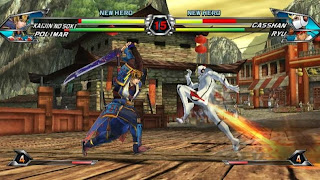
Moving on, I can honestly say that TvC represents another smooth return to form for Capcom and their incredible 2D beat’em up legacy. Whilst it may not be perfect, and lacks the long-term longevity that garners the rabid SFIV fan base, it does have its foot firmly in the dojo. And I can definitely see a small, but strong, hardcore following continuing to play and master all the intricacies available, both at home and in the arcade scene.
Admittedly, some may find the lack of recognisable faces a turn off, or the eccentric nature of the presentation and music off-putting, but I would urge them to give this a go. Especially any fans of previous 2D fighting games or even a more casual user who just recently got into Street Fighter IV. There’s a lot of fun to be had, and it would be such a shame if it all got lost due to unfamiliarity with the source material, or the inhibition to try something different.
Overall, the foundations have been solidly laid, and will no doubt be revised and expanded upon with the inevitable sequel. Given the quality and success that Tasunonko Vs Capcom deserves, it couldn’t come sooner. We highly recommend anyone with a penchant for 2D fighting games to pick this up and show your support, it’s worth it.
VERDICT: 8/10

Really interesting review, Dave.
ReplyDeleteI'm glad the game is good.